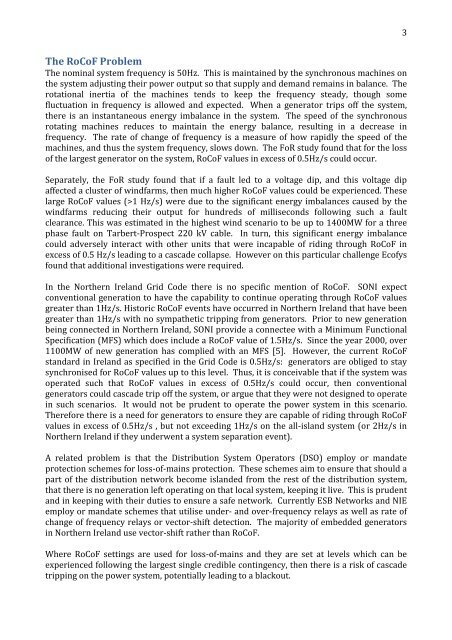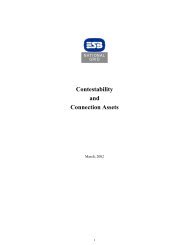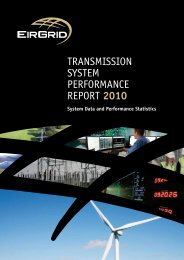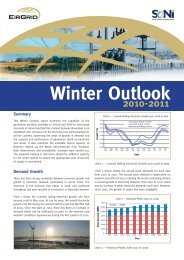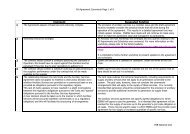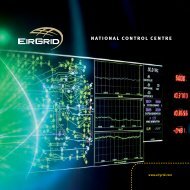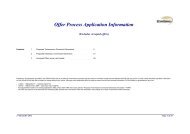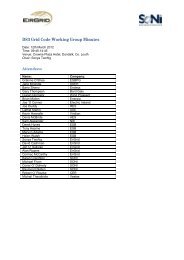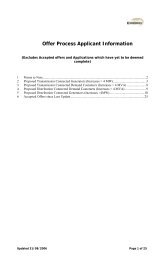RoCoF Modification Proposalâ TSOs' Recommendations - Eirgrid
RoCoF Modification Proposalâ TSOs' Recommendations - Eirgrid
RoCoF Modification Proposalâ TSOs' Recommendations - Eirgrid
Create successful ePaper yourself
Turn your PDF publications into a flip-book with our unique Google optimized e-Paper software.
3The <strong>RoCoF</strong> ProblemThe nominal system frequency is 50Hz. This is maintained by the synchronous machines onthe system adjusting their power output so that supply and demand remains in balance. Therotational inertia of the machines tends to keep the frequency steady, though somefluctuation in frequency is allowed and expected. When a generator trips off the system,there is an instantaneous energy imbalance in the system. The speed of the synchronousrotating machines reduces to maintain the energy balance, resulting in a decrease infrequency. The rate of change of frequency is a measure of how rapidly the speed of themachines, and thus the system frequency, slows down. The FoR study found that for the lossof the largest generator on the system, <strong>RoCoF</strong> values in excess of 0.5Hz/s could occur.Separately, the FoR study found that if a fault led to a voltage dip, and this voltage dipaffected a cluster of windfarms, then much higher <strong>RoCoF</strong> values could be experienced. Theselarge <strong>RoCoF</strong> values (>1 Hz/s) were due to the significant energy imbalances caused by thewindfarms reducing their output for hundreds of milliseconds following such a faultclearance. This was estimated in the highest wind scenario to be up to 1400MW for a threephase fault on Tarbert-Prospect 220 kV cable. In turn, this significant energy imbalancecould adversely interact with other units that were incapable of riding through <strong>RoCoF</strong> inexcess of 0.5 Hz/s leading to a cascade collapse. However on this particular challenge Ecofysfound that additional investigations were required.In the Northern Ireland Grid Code there is no specific mention of <strong>RoCoF</strong>. SONI expectconventional generation to have the capability to continue operating through <strong>RoCoF</strong> valuesgreater than 1Hz/s. Historic <strong>RoCoF</strong> events have occurred in Northern Ireland that have beengreater than 1Hz/s with no sympathetic tripping from generators. Prior to new generationbeing connected in Northern Ireland, SONI provide a connectee with a Minimum FunctionalSpecification (MFS) which does include a <strong>RoCoF</strong> value of 1.5Hz/s. Since the year 2000, over1100MW of new generation has complied with an MFS [5]. However, the current <strong>RoCoF</strong>standard in Ireland as specified in the Grid Code is 0.5Hz/s: generators are obliged to staysynchronised for <strong>RoCoF</strong> values up to this level. Thus, it is conceivable that if the system wasoperated such that <strong>RoCoF</strong> values in excess of 0.5Hz/s could occur, then conventionalgenerators could cascade trip off the system, or argue that they were not designed to operatein such scenarios. It would not be prudent to operate the power system in this scenario.Therefore there is a need for generators to ensure they are capable of riding through <strong>RoCoF</strong>values in excess of 0.5Hz/s , but not exceeding 1Hz/s on the all-island system (or 2Hz/s inNorthern Ireland if they underwent a system separation event).A related problem is that the Distribution System Operators (DSO) employ or mandateprotection schemes for loss-of-mains protection. These schemes aim to ensure that should apart of the distribution network become islanded from the rest of the distribution system,that there is no generation left operating on that local system, keeping it live. This is prudentand in keeping with their duties to ensure a safe network. Currently ESB Networks and NIEemploy or mandate schemes that utilise under- and over-frequency relays as well as rate ofchange of frequency relays or vector-shift detection. The majority of embedded generatorsin Northern Ireland use vector-shift rather than <strong>RoCoF</strong>.Where <strong>RoCoF</strong> settings are used for loss-of-mains and they are set at levels which can beexperienced following the largest single credible contingency, then there is a risk of cascadetripping on the power system, potentially leading to a blackout.


